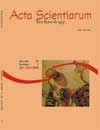The coulombian repulsion does not explain the exploding wire phenomenon
DOI:
https://doi.org/10.4025/actascitechnol.v21i0.3080Keywords:
efeito Hall radial, explosão de fios, repulsão coulombianaAbstract
In this article we consider the exploding wire phenomenon which happens when a high electric current flows in the wire. We present the result of the Coulombian tension. This tension is generated by charge densities in the wire, caused by the radial Hall effect. We conclude that this tension means several orders of magnitude smaller than the necessary one to break a metallic wire.Downloads
Download data is not yet available.
Downloads
Published
2008-05-14
How to Cite
Assis, A. koch T., & Hernandes, J. A. (2008). The coulombian repulsion does not explain the exploding wire phenomenon. Acta Scientiarum. Technology, 21, 837–839. https://doi.org/10.4025/actascitechnol.v21i0.3080
Issue
Section
Physics
License
DECLARATION OF ORIGINALITY AND COPYRIGHTS
I Declare that current article is original and has not been submitted for publication, in part or in whole, to any other national or international journal.
The copyrights belong exclusively to the authors. Published content is licensed under Creative Commons Attribution 4.0 (CC BY 4.0) guidelines, which allows sharing (copy and distribution of the material in any medium or format) and adaptation (remix, transform, and build upon the material) for any purpose, even commercially, under the terms of attribution.
Read this link for further information on how to use CC BY 4.0 properly.











8.png)




